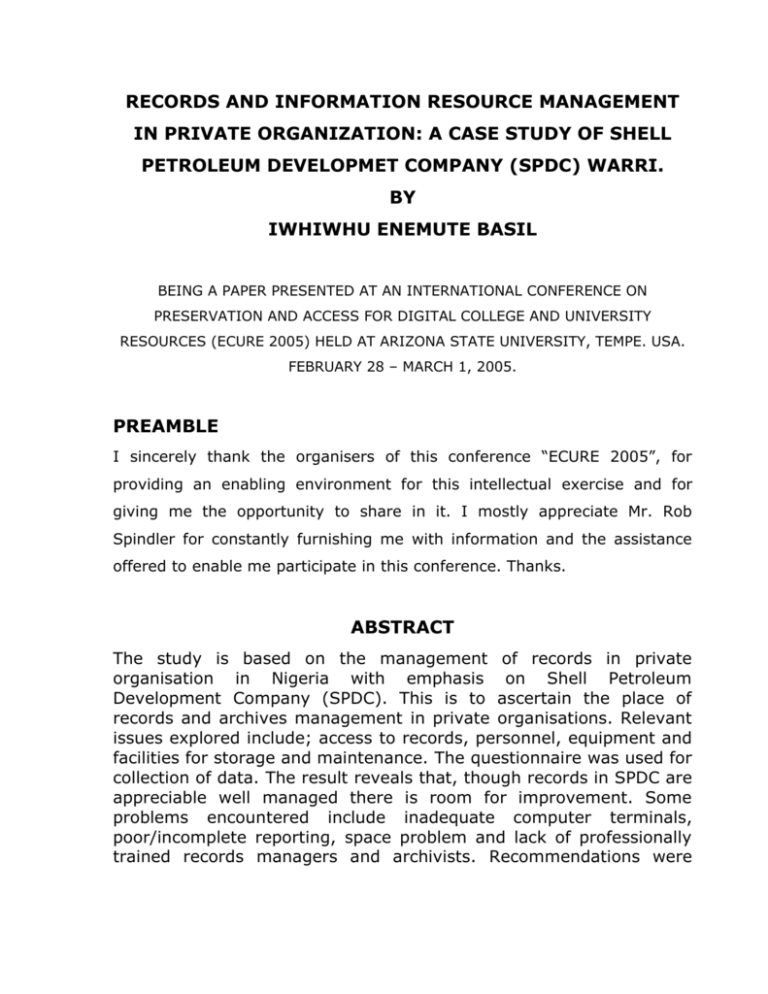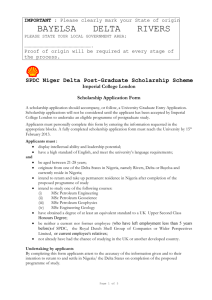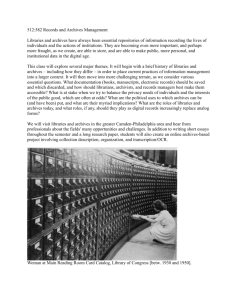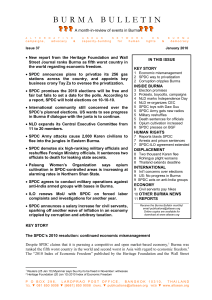Iwhiwhu_doc - Arizona State University
advertisement

RECORDS AND INFORMATION RESOURCE MANAGEMENT IN PRIVATE ORGANIZATION: A CASE STUDY OF SHELL PETROLEUM DEVELOPMET COMPANY (SPDC) WARRI. BY IWHIWHU ENEMUTE BASIL BEING A PAPER PRESENTED AT AN INTERNATIONAL CONFERENCE ON PRESERVATION AND ACCESS FOR DIGITAL COLLEGE AND UNIVERSITY RESOURCES (ECURE 2005) HELD AT ARIZONA STATE UNIVERSITY, TEMPE. USA. FEBRUARY 28 – MARCH 1, 2005. PREAMBLE I sincerely thank the organisers of this conference “ECURE 2005”, for providing an enabling environment for this intellectual exercise and for giving me the opportunity to share in it. I mostly appreciate Mr. Rob Spindler for constantly furnishing me with information and the assistance offered to enable me participate in this conference. Thanks. ABSTRACT The study is based on the management of records in private organisation in Nigeria with emphasis on Shell Petroleum Development Company (SPDC). This is to ascertain the place of records and archives management in private organisations. Relevant issues explored include; access to records, personnel, equipment and facilities for storage and maintenance. The questionnaire was used for collection of data. The result reveals that, though records in SPDC are appreciable well managed there is room for improvement. Some problems encountered include inadequate computer terminals, poor/incomplete reporting, space problem and lack of professionally trained records managers and archivists. Recommendations were made to improving records management practices in SPDC and other organisations in Nigeria. INTRODUCTION Records and information are a corporate resource. It enables an organisation to operate smoothly and achieve its goals. Shell Petroleum Development Company (SPDC) is a Multinational organisation with branches worldwide. Nigeria is one of the nations hosting SPDC, being an Oil producing nation. It is the pioneer and the largest hydrocarbon exploration and production company in the country. It was originally known as Shell D’Archy and later Shell BP (shell British Petroleum), and started its operations in 1937 but was given an oil exploration licence on November 4, 1939. The company discovered the first commercial oil field at Oloibiri in Bayelsa state in 1956, and through a sustained exploration effort had since discovered more oil fields which have firmly established the company in Nigeria. From a modest production of 6,000 barrels of crude oil per day in 1958, its production capacity as date has increased to 1,000,000 barrels of oil per day. Though, they have the capacity of producing over 1.3 million barrel per day. In support of its mission and realisation of objectives, SPDC creates, receives and maintains records which document the functions, activities and transactions carried out in the cause of its operations. These (records) are the basis for organizational accountability, compliance with legislative requirements and the development of the “corporate memory.” The ability to identify, and locate information which is critical for current decision-making, and to determine what policies and procedures were followed during the conduct of business is essential to the operations of SPDC. One cannot adequately talk about information and its importance without making reference to records. Information is generated from records, what ever may be the source of information available to an organization, be it internal or external origin, is derived from records. Information and records are thus two phenomena which have much to do with each other. Information is an inherent part of record and can be described as being record, regardless of the format or media on which they appear. Records play an immeasurable role in administration, because managers and administrators employ it on a routine basis as an aid in carrying out diverse administrative duties especially in decision-making. The information received helps to enlighten and educate them on issues relevant to themselves and the organization. Hence, there is a great need to manage records and information resource effectively in order to achieve administrative effectiveness and to cut down organization’s expenditure on records. Records and information resource management is a management tool, which cannot be dispensed within any organization, owing to the important role it plays in administration. Effective record keeping is sine qua non to administrative effectiveness in organisations. It assures adequate documentation to make possible, rapid retrieval of information contained therein, whenever needed; secure maintenance, and lastly, the regular retirement procedures that simultaneously remove from active file the costly and confusing cluster of obsolete records and make provision for the preservation in the archives, of the small fraction of which has continuing value. BACKGROUND INFORMATION ON SPDC OPERATIONAL RECORDS IN NIGERIA Shell Petroleum Development Company (SPDC) is the pioneer and leader of the petroleum industry in Nigeria. It has the largest acreage in the country from which it produces some 50 percent of the nation’s petroleum products. The company’s operations are concentrated in the Niger Delta and adjoining shallow offshore areas where it operates in an oil mining lease of around 81,000 kilometres. SPDC has more then 6,000 kilometres of pipe lines and flow lines, 87 flow stations, 8 gas plants and more than 1,000 producing wells. The company has generated over the years, lots of records which this study is aimed at reviewing to know how these records are being maintained and managed. This study would also focus on the usefulness of these generated records and if there is a central body that manages the raw data gathered from the field with the aim of providing useful information for the smooth operations of the company. THE PROBLEM The world today is considered an information society, as a result of the fact that information has rapidly become the driving force behind the development of nations. Saxby (1990) noted that the communication of information has provided the raw materials for societal development. Development is significantly enhanced by information. Information is both an integral part of development and a powerful instrument for furthering the process of development. In this regard, development refers to the degree to which a society has improved its environment in terms of social, economic and political well-being. What keeps most organization going in any modern system of administration are “records”, which are used for planning, decision-making, and control. This is made easier with the introduction of the information and communication technology. Telfer (1998) admits that technology has served libraries well and that it has fulfilled its promise by eliminating tedium of organization and access tasks. Despite the value of records as corporate memory of the organisation that created them, proper management of records that will result in use, maintenance and disposition is hardly given high priority in organisations in Nigeria. It is often observed that despite the invaluable role record play in organisations, officials often exhibit misconceptions and indifference to the management of records. For relevant information policies to be established and document management systems developed, policy makers and developers must see the highly interconnected nature of information, documents and records. Because for some reasons managers usually are very interested in the use of information in the work place but are disdainful of records management practices, this gives one course to wonder. As a result, this study will focus on SPDC records with emphasis on how SPDC generate records, the kinds of information contained in the records, use of the records, problems encountered in the course of using the operational records as information sources, the format in which records appear, storage facilities, access to records, users, information safety etc. SPDC as a multinational company, no doubt would have generated volumes of records and the problem of managing these records is imminent. This study is an attempt to unravel the misery behind the poor record management practices in Nigeria. The following questions shall be used as a guide; Is there any policy governing the management of records in SHELL? Are there professionally trained Records Managers/Archivists managing the records? Are there acquisition policy, retention and disposition schedule? What records are created and used by SPDC? How are the records stored and used? Do they have a Record Centre and or Archival Institution? THE PURPOSE Despite the National Archives Decree (1992) which gives impetus to the management of records in Nigeria (both public and private) research has shown that public records are not managed with the guidelines provided in the Decree. A study by Iwhiwhu on the National Electric Power Authority and Nigerian Universities reveals that those administering the records are not aware of this decree. (Iwhiwhu, 1998, 2004 and 2005). To make a balanced judgement, there is need to consider the records of private organisations and make a case for the full implementation/enforcement and or problems encountered with the Decree since the earlier studies were mainly on public organisations. The research therefore, is aimed at investigating the need for organizations in Nigeria to embrace the records and information resource management programme for effective and efficient management of organizations by managers, or administrators for the full realization of organizational goals. This study shall focus on the operational records of SPDC, Warri office where seismic records are created, disseminated and used for Shell operations. RESEARCH METHODOLOGY This research method used is mainly the survey method through the use of a questionnaire. It however used observation and interview methods as well. A total of 100 questionnaires were administered and only 62 were retrieved from respondents amongst the group under study (Chart I). Of these 100 questionnaires, 30 were administered to custodians of the understudied records while 70 were administered to the field workers mainly in operations/production departments. Data collected were analyzed and results fully interpreted. Discussions were made, conclusion drawn and appropriate recommendation(s) made. Chart I: Questionnaires Administered 70 60 50 Number returned 40 Number not Returned 30 20 10 0 RESULT AND DISCUSSION OF FINDINGS BACKGROUND INFORMATION Results from the study reveal that the respondent’s age ranges from 26-45 years. Both male and female respondents from different department were involved in this study. Some married while some were singles. But the study showed that, field respondents consists only of males, while the records custodians include few females as custodian of records in SPDC (chart II and III). Chart II: Sex Distribution 60 50 40 Male 30 Female 20 10 0 Chart III: Age Distribution - 26 – 35 Years 36 – 45 Years The result also show that outside the custodians of the records who are mainly librarians, engineers in the various areas or field of engineering were involved in records generation. The result reveals that field workers were the generators of the records while those in the office were the custodians of the records. This is with regards to the records under study. It therefore means that records custodians are mainly Librarians and not trained Records Managers and or Archivists. Table I: Working Experience Working Experience Frequency Percentages (%) 1 – 5 Years 60 97 6 – 10 years - - 11 – 16 years - - 16 years and above 2 3 31 100 Total The result from table one shows that the working experience of the respondents ranged from within 1 – 5 years (60, 97%) and two had over 16 years (3%) working experience. This is so because SPDC have contract staff in the library and archives. The implication is that such staff could be changed from time-to-time. Though this is not proper for the management of a sensitive aspect of an organisation like records, the reason for this is best known to SPDC management. Since good record keeping requires experience which make for efficiency. SPDC RECORDS GENERATION AND USE From Chart IV below, 8 (13%) respondents said records are generated from field reports, by sourcing and gathering of data and inspection and auditing respectively while 2 (3%) said it is on the job development, and documentation respectively. Others, 18 (29%) said it is from field location and observation, 6 (10%) said it is from authorised personnel and 4 (6%) from manual data gathering. Chart IV: Records Generation 20 15 10 Series1 Internally generated by Inspection and Auditing Authorised Personnel On The Job Development Field Reports 5 0 On what records are used by SPDC in their operations, the result revealed that 6 (19%) respondents are of the opinion that field records related to health, safety and environment are used, 19 (61%) said records for operation are from reports and production data, 2 (7%) said records for operations are from daily operational records. Chart V: Means of Generating Field Records 25 20 15 10 5 0 Use of process instrument Development and Production Teams Electronic and Operator Interface Series1 The result shows that majority of the field information are obtained from field reports, 14 (23%) and Inspection and audit/observation, 20 (32%) as indicated by the respondents. Other means are through the development and production teams, Production Section on Daily basis and use of process instruments were 4 (6%) respondents respectively. While 2 (3%) indicated that it is through electronic and operator interface and by asking questions/photography respectively. Having obtained this information a report will be written and sent to the library for safe keeping. This involves data collection, analysis, vetting, cross referencing, logging, scrutiny by appropriate authority etc. The report then goes to the library through document controller, personal delivery by team supervisor(s) etc after notifying the library through an initial e-mail sent by the originating department. Chart VI: Records Used in SPDC Field Records (H.S.E) Reports And Publication Data Corporate Memory Records Daily Operational Records The result revealed that some records are generated from field records (H.S.E), 12 (19%), reports and publication data, 38 (61%), Corporate Memory Records, 4 (17%), Daily Operational Records, 8 (13%), location/observation, documentation among others as shown in chart VI. Also the formats in which these records exist shows that majority of the field workers had no idea while others indicated that they appear in microfilm, CD ROM, transparencies, video tapes/CD, audio tapes and Papers. The result shows that the record content are daily production records, daily operations jobs, and daily maintenance job. Though majority of the respondents are not aware of the content of records, it goes to show the strict control and restriction placed on operational records. Chart VII: Purpose of Record Generation/Use Monitoring Production Appraisal Improve Productivity Planning The result shown on chart VII indicates that 8 (13%) respondents said it is used in monitoring productivity, planning and appraisals respectively while 4 (7) said it is to improve productivity. Other 34 (55%) had no idea. However, all respondents confirmed the use of records in enhancing performance and productivity. As a result, it leads to the achievement of SPDC organizational objectives. None-the-less, problems are also encountered in the cause of using these records. The respondents indicated that there is problem of incorrect report which affects production and decision and this leads to operation difficulties / failures. The result shows that operational records are administered or managed by the librarian/”Archivist”. Others are of the view that they were managed by field workers and operational managers of each records generating department. This is so because while a copy of the generated records goes to the library/archives, the generating department also keeps a copy for their records. These respondents’ view may be that they are ignorant of the copy sent to the library/archives. RECORDS STORAGE AND MAINTENANCE The respondents noted that the library has the required storage facilities for records. Personal observation shows that they have mobile steel shelves in addition to wooden shelves, cabinets, computer and racks. The Library software used for records storage is initially LIPSIS later to Ms-office applications - EDMS (Electronic document management system) and presently live link. This migration from one software package to the other is as result of the need to have user friendly software to facilitate storage and retrieval of information materials. The security measures put in place to protect the records from damage or theft include: pass wording systems, security guard in library, electronic data facilities for accessing information on the database, unauthorised users are not allowed into the library. As such there is defined access control; air conditioners are provided to maintained temperature and humidity, quarterly fumigation, fire hazard prevention measures and external back-up systems for electronic records. The storage and management of records in the archives is boxing and keeping records in stacks. The retrieval tools are; the index, register and catalogue. Library users are mainly the custodians or the records generators. However, some uses the library through their PC in their personal offices. The response from the respondents reveals that they are satisfied with the present mode of information dissemination in S.P.D.C except for those who have no access to PCs in their offices hence the need for more PCs to facilitate some of the services cannot be overemphasised, and the reports should be sent to the library after conclusion of a field work/operation. PROBLEMS ASSOCIATED WITH RECORDS MANAGEMENT There is the problem of determination of information needs of users and inability of departments to submit report to the library in good condition. As a result there is retrieval problem over stored information. Also, space problems were emphasised in both the library and the archives. ACCESS TO SPDC RECORDS Shell Petroleum Development Company (SPDC) keeps its document in both hard copy and electronic formats. The electronic records are stored in databases which are made available to staff of SPDC through various computer terminals within the organisation. Users can browse the sww/www from various work- stations, and those without access usually on request, information is downloaded and disseminated to them with restrictions on non-business sites. That is, only business sites can be accessed freely via workstations. Other information that are regarded as confidential but on their database catalogue requires the user’s physical presence at the co-operate library to use such material because they are not allowed to be taken outside the library. Users are expected to come physically to borrow books. All library users must have their SPDC ID card on them whenever they are in the library. The use of the confidential rooms requires authorization from the H.O.D of the user and external users usually do not have access to these rooms. Industrial Training students and youth corpers can use the library but cannot borrow books from the library. Contract staff are not allowed to use the library or borrow books from the library. For research purposes, a letter of recommendation from the researcher’s institution to the Directorate of Petroleum Resources (DPR) to SPDC, and a confirmation letter from DPR give access to the library materials. The operational records of SPDC are not accessible to members of the public except for research documents, general information records, manuals, bulletin and that which has interface with third party and non business documents. Seismic records in SPDC usually consist of reports on various field operations i.e. reports on how a potential site was discovered, how the drilling of oil started, the instruments used in the process, detailed drilling instruments, and processes, area measurement and manpower requirements, communication instruments like telephone lines and gopher lines. Seismic records usually contain detailed reports of off-shore operations and they usually contain the same information although with slight deferral in the location, (maybe different drilling technique and sometimes ethnic disturbances). These records are usually confidential, they are not to be copied and only a catalogue of them is provided on their database. They are stored in the corporate library of Shell. SUMMARY AND CONCLUSION The result of this research shows that to a large extent, employees of SPDC are ignorant of the happenings in the library and they also exhibit a nonchalant attitude towards records. The few who took their time to know the life - cycle of records in SPDC seems to be satisfied with their present operations except for a very few who ventured to voice out their opinions. Though the management of records and information resources in SPDC are appreciable, there is room for improvement. RECOMMENDATION Based on the findings of this research, it is recommended that S.P.D.C should; 1 Employ professionally trained records managers and archivists and send the present staff for on the job training in archives and records management. 2 Organise seminars / workshops to educate their staff on the need to manage records more efficiently. 3 Put in place Library Education for the workers. 4 Provide more PC’s so as to create more terminals and access points to the library collection. 5 Send reports (records) to the library as soon as they are written and concluded upon. 6 Ensure that forwarded reports are not distorted either from the content or context and format. 7 Confirm reports and ensure that they are accurate before they are written and sent to the library. REFERENCES Eta, Patrick. (1996). The administrator’s perception of archives and their role in government. Archival Review (JANUS) ICA PAN-African Conference. 1996. 1. P. 10. Federal Republic of Nigeria (1992) National Archive Decree. July 8. Iwhiwhu, Enemute Basil (1998). Management of non-current records, in the National Electric Power Authority, Dissertation), Ibadan: University Headquarters-Lagos. (Master of Ibadan. P. 16. Iwhiwhu, Enemute Basil (2004) Institutional Archives: an essential aspect of university growth and development. Frontiers of Information and Library Science (FILS). Vol 1. No. 2. Iwhiwhu, Enemute Basil (2005). Managing records in Nigerian Universities: problems and prospects. The Electronic Library. Vol. 23. no. 3. Saxby Stephen (1990) The age of information: the past development and future significance of computing and communication. London: Macmillan. P. 2. SPDC website. http://www.shell.com Telfer Margaret information. (1998) Librarians, FELICITER 44 technology (3). P. 1 and - 5. http://www.mgmt.dal.ca/slis/etig/ifcomn/ITL/libr.html economics of available at Mr. IWHIWHU, Enemute Basil is an Assistant Lecturer with the Department of Library and Information Science in Delta State University, Abraka Nigeria. He obtained a B. Sc. (Ed) Honours Degree in Chemistry from the defunct Bendel State University, Ekpoma, 1991 and Mater Degree in Archives and Records management (MAS) from the University of Ibadan, 1998. He worked as a Librarian for ten years before moving to the Department of Library and Information Science in the same University.








